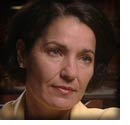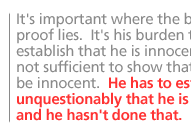|
What harm would there be in giving Roy Criner another trial?

 |
Interview with Judge Sharon Keller, Texas Court of Criminal Appeals.
She
wrote the majority opinion in the Roy Criner case, ruling that new tests which
showed DNA evidence in the rape and murder case was not Criner's didn't
warrant granting Criner a new trial |  |
A lot of things must be considered before giving someone another trial.
Finality of judgements is important. . . At best, DNA evidence establishes that
someone else had sex with this girl, who was promiscuous. That is simply not
enough to overcome the compelling nature of his confessions to his friends that
he picked up a girl and raped her. He said he raped a girl. The only question
at trial was whether the victim in this case was the person that he raped. The
DNA test is not proof that he is innocent. It's negative evidence, instead of
positive evidence. A jury has determined that he's guilty. When you look at
new evidence, you look at it to see whether it would have made a difference in
their verdict. If it would, he gets a new trial. If it wouldn't, then he
doesn't.

But you're not the jury.
He's had a fair trial with 12 jurors deciding his guilt. . . This DNA test
gives negative, not positive, evidence. It would not have made a difference in
the jury's verdict. . . Nobody knows for sure. But no state ever says, "I'm
not sure. Let's just give him a new trial." Before trial, it's up to the
state to prove that he's guilty. Now, it's up to him to prove that he's
innocent. That's his burden under the law: Has he unquestionably established
that he's innocent?

You think not.
He had an opportunity at the writ hearing to say why he was confessing, and why
he was telling people that he had raped a girl if he hadn't. He didn't offer
any explanation about who he said he raped, if he raped someone, why he said it
if he didn't rape someone, or if he took his victim to her grandmother's house.
. . It's not up to me to believe him or not. It's up to the jury to believe.
And they believed he did what he said he did. . . He's in jail for 99 years for
aggravated sexual assault. That's the charge he was tried on and convicted of.
That's what he said he did. . .

Doesn't the DNA evidence raise new questions?
In Texas, the legal test to get relief after your conviction is final-- and
after your direct appeal is through--is: "Has he unquestionably established
that he is innocent?" That's what the appellate court looks at. "Has he
established clear and convincing evidence that no rational juror would have
found him guilty?" I think the record shows that he has not. . .

So the DNA evidence didn't sufficiently impress you?
 |
 DNA evidence means different things in different contexts. It's like
fingerprint evidence. If someone's fingerprints are at the scene of a crime,
that means the person was there at some time or another. But if his
fingerprints aren't there, it doesn't prove that he's innocent of a crime
committed at that scene, especially if he's told people that he committed the
crime. . .Two days after he confessed to his friends, one friend brought Mr.
Criner a newspaper and said, "This is an awful lot of coincidences." At that
point, Mr. Criner said, "I didn't rape her. I took her to her grandmother's
house in New Caney." The victim was going to her grandmother's trailer house
in New Caney, and she didn't get there. She was murdered. If that was not the
girl that he picked up and raped, was it a coincidence that some other girl
that he picked up hitchhiking was going to her grandmother's trailer house in
New Caney? That changed story was supposed to show his innocence. But it made
him look guilty. . .
DNA evidence means different things in different contexts. It's like
fingerprint evidence. If someone's fingerprints are at the scene of a crime,
that means the person was there at some time or another. But if his
fingerprints aren't there, it doesn't prove that he's innocent of a crime
committed at that scene, especially if he's told people that he committed the
crime. . .Two days after he confessed to his friends, one friend brought Mr.
Criner a newspaper and said, "This is an awful lot of coincidences." At that
point, Mr. Criner said, "I didn't rape her. I took her to her grandmother's
house in New Caney." The victim was going to her grandmother's trailer house
in New Caney, and she didn't get there. She was murdered. If that was not the
girl that he picked up and raped, was it a coincidence that some other girl
that he picked up hitchhiking was going to her grandmother's trailer house in
New Caney? That changed story was supposed to show his innocence. But it made
him look guilty. . .

But now this can be weighed against the new DNA evidence.
I don't think the jury's verdict would have been any different, even if they'd
had the DNA evidence back then. The state would have explained that the girl
was promiscuous, and might have shown that she'd had sex with different people.
. . It's important where the burden of proof lies. It's his burden to
establish that he is innocent. It's not sufficient to show that he might be
innocent. He has to establish unquestionably that he is innocent, and he
hasn't done that.

Is the victim's promiscuity the best explanation for the DNA test
results?
The state argued that [Criner] could have worn a condom, or he could have
failed to ejaculate. They mentioned a rape conviction where the rapist did not
ejaculate. Another possibility is a third person. . .

Do you believe in the possibility of the third person?
Nothing in the record would particularly support that. . .

Why would he wear a condom to cover up his action, and then, a few hours
later, brag to his friends about having committed the crime?
People who commit offenses do things that are very strange. I don't know
whether he was wearing a condom or not. That was just a theory by the state.
The fact that this man bragged about beating and raping a girl is very strange,
whether he did it or not. It's something that a normal person wouldn't
understand. But criminals do things that normal people don't understand. .
.

Didn't the DNA test refute the original blood evidence?
The [original serology] evidence showed that the blood group substance found on
the victim's body could have been put there by anyone having Type O blood.
Something like 44% of the population, or even the victim herself, could have
deposited that blood group substance, including Mr. Criner. . . I think it's
clear the jury was not relying on this [evidence] when they decided that he
committed the offense. . .That's not sufficient to support a conviction.

So it comes down to his statements to his friends?
He had no explanation about why, on the night this girl was murdered, he told
three people that he had picked up a girl and raped her. And it was his burden
to put on that kind of evidence. The absence of physical evidence that Roy
Criner raped this woman doesn't prove his innocence. Essentially, his confessions were the evidence against him. . . That was
essentially what he was convicted on. If a person confesses to a crime, the
conviction should be affirmed on appeal if there's corroborating evidence that
the crime actually occurred. So, yes, that's sufficient evidence on appeal. .
.

How can Roy Criner establish his innocence?
I don't know. . .

Has justice been served in this case?
Justice is served by allowing the criminal justice system to function by the
rules that are in place to determine the truth. That is the function of all
our rules and standards. I abide by those standards, because they are the
surest way to determine the truth. . . As a judge, I look at what the law
requires, which is that he unquestionably establish that he is actually
innocent. That was my focus in reviewing this case. It's the jury's job to
speculate about whether a person is actually innocent or actually guilty. I
review the propriety of the conviction by whatever legal standards are in
place.

So it was a proper conviction even if it leaves open the question of his
actual innocence?
[Roy Criner] did not meet his burden to prove that he is actually innocent of
this offense. At best, he established that he might be innocent. We can't
give new trials to everyone who establishes, after conviction, that they might
be innocent. We would have no finality in the criminal justice system, and
finality is important. When witnesses testify, and when jurors return a
verdict, they need to know that they can't come back later and change their
minds. . . DNA evidence in this case did not prove that he didn't commit the
offense. That's the standard we use, and he didn't prove it. At best, he made
some people think that he might be innocent. But he didn't prove it.

home ·
cases ·
speaking out ·
total system failure? ·
how far will it go? ·
video ·
discussion
interviews ·
synopsis ·
tapes & transcripts ·
press
web site copyright WGBH educational foundation
|  |